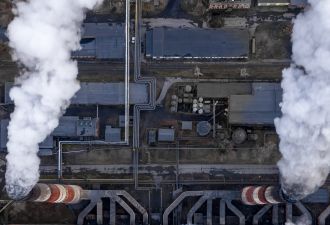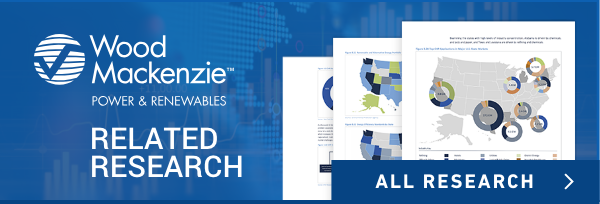GE Renewable Energy made a bold statement on Thursday: It intends to lead in the offshore wind market.
The company plans to deploy what would be the world’s most powerful offshore wind turbine -- the 12-megawatt Haliade-X -- in 2021. That's up from GE's existing 6-megawatt turbine product, and it would be capable of producing 45 percent more electricity than the largest offshore wind turbine deployed today.
The aggressive timeline and ambitious scale-up of its flagship offshore turbine makes clear GE’s eagerness to pass industry leaders MHI Vestas and Siemens Gamesa Renewable Energy.
GE Renewable Energy will invest $400 million over the next three to five years to develop and deploy the Haliade-X. The turbine will reach a maximum height of 260 meters above the sea and be outfitted with 107-meter-long blades, which marks the first formal announcement of a turbine blade longer than 100 meters, according to Dan Shreve, partner and analyst with MAKE Consulting.
The ability to deploy blades at that scale “underlines the importance of GE's acquisition of ultra-long blade specialists, LM Wind Power,” said Shreve in an email.
GE estimates the Haliade-X will achieve a 63 percent capacity factor, at least several points better than existing industry-leading offshore turbines, said John Lavelle, GE Renewable Energy’s CEO of offshore wind, on a press call. Each percentage point increase in the capacity factor, he said, is worth $7 million.
Bid to leapfrog the market leaders
GE is playing catchup because the capacity of its 6-megawatt offshore turbine, which was installed at the Block Island Wind Farm off the coast of Rhode Island, lags behind MHI Vestas and Siemens Gamesa. MHI Vestas announced the launch of a 9.5-megawatt turbine in June 2017.
Greentech Media recently reported that MHI Vestas will test the gearbox and main bearings of the turbine at Clemson University in South Carolina. MHI Vestas’ 8-megawatt offshore turbine was deployed commercially for the first time at the Burbo Bank Extension project in the U.K., which opened in May of last year.
Siemens Gamesa’s 7-megawatt offshore turbines were recently installed in a commercial project for the first time at the Walney Extension offshore wind farm in the U.K. The company announced last month its 8-megawatt offshore turbine would be deployed at Ørsted’s massive 1.4-gigawatt Hornsea Project Two, also in the U.K.
“The announcement of the Haliade-X is a clear indication of GE’s commitment to the global offshore wind market,” said Shreve. “GE’s commitment to the market had been called into question given its overall lack of engagement in the sector outside of France.”
“GE had fallen far behind its peers on new product development initiatives,” he added, “with only a handful of Haliade 6-megawatt turbines in the water by the end of 2017. GE made the right move in taking an aggressive approach to leapfrog the current market leaders.”
A tight timeline
John Lavelle acknowledged that the shipping timeline for the Haliade-X is aggressive. GE Renewable Energy plans to lock down the bill of materials, final designs and place purchase orders for the turbine this year.
By early 2019, GE wants to be shipping components ahead of a prototype test. Testing will continue through 2019 and into early 2020. Lavelle said the turbine is already being bid for projects and GE is making commitments to customers.
Asked on the press call about the risk about jumping directly from a 6-megawatt turbine to a 12-megawatt turbine, Lavelle was bullish on GE’s ability to deliver.
“It’s not something...for the faint of heart,” he said. “You really want to differentiate yourself. You want to stretch the technology as far as you can in your comfort zone of what’s practical.”
He went on: “But developing a 12-megawatt technology, leveraging your experience with the 6 MW, is something that very few companies can do. This is something GE can do.” He said GE has made similar leaps in the past in aviation and gas turbines.
Dan Shreve cautioned that GE may have its work cut out for it to convince customers it can ship the Haliade-X on such a tight timeline.
“The lack of a substantial installation base for the 6 MW turbine may inhibit adoption of the 12 MW turbine in current RFQs [requests for quotation], and it places tremendous pressure on the organization to execute a successful rollout of the prototype next year,” he said. “GE will need to be closely engaged with European offshore wind installation specialists to ensure the proper infrastructure is in place to deliver on the gigawatt-class wind projects that GE is banking on to re-establish itself in the offshore market.”
Vestas and Siemens Gamesa announcements coming soon
Don’t expect GE to hold the title for the world’s most powerful offshore wind turbine for long. MHI Vestas and Siemens Gamesa, which led turbine makers with 2.7 gigawatts of offshore turbines commissioned in 2017, are expected to announce similar turbine launches soon.
“MAKE is expecting a host of formal announcements from GE peers following the Haliade-X announcement,” with MHI Vestas and Siemens Gamesa both expected to announce 12+ megawatt offshore turbines with rotors larger than 200 meters, said Shreve.




